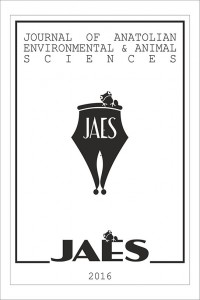Öz
In this study, physiological reaction of the Black Sea trout was aimed to identified, during the Black Sea transferring period to Black Sea (18‰).After salty water treatment of the two similar groups in November, individual morphometric adaptation success was identified. Fish in both groups were sorted evaluated fish parr marks formations, because of smoltification adaptation success. As a result of the analysis, it was observed that Black Sea trout could be successful after total length of 11.5 cm. Experimental fish group, measured as 11 cm mean length and 11.6 g mean weighed were divided two similar groups randomly. Both groups were fed
under the Black Sea salinity and fresh water condition during the November-April period. At the end of the five moth feeding period, mean lengths were reached to
15.8±2.79 cm in seawater, 16.1±2.05 cm in fresh water conditions. During the exposure of the required size fish to 18‰ salinity, blood plasma sodium and chlorine ion concentrations were increased in first 3 days, then stabilized after 7th day. Blood potassium ion concentration were decreased until 17th day, then stabilized. When fish were exposed to ocean salty water (30‰), blood ion concentrations were relatively stabilized after 14th day. During the salty water adaptation period, there is no mortality under 18‰ salty water, but totally 10% mortality was observed in 30‰ salty water exposures. As a conclusion, it was determined that Black Sea trout bigger sized than 11.5 cm length could be adapted to Black Sea salinity (18‰), and physiologic adaptation duration could be reached to 17 days. During the releasing applications to the marine water of the Black Sea trout, if 17 day adaptation period of the identified minimum capable sized fish are taken in to consideration, groups’ competition ability and survival rate will be increased.
Anahtar Kelimeler
Blacksea sea going trout Salmo trutta labrax Marine ecotype Fecundity Growth
Kaynakça
- Arslan M., Aras NM. ve Yıldırm A., (2000). Cenker Çayı (Çoruh
- Havzası)’nın Populasyon Yapısı ve Büyüme Özellikleri, Su
- Ürünleri Sempozyumu, 20-22 Eylül, Sinop, 266-278.
- Baglinière JL., (1999). Introduction: The Brown Trout (Salmo trutta L.)-
- Its Origin, Distribution and Economic and Scientific
- Significance, Biology and Ecology of the Brown and Sea Trout,
- Praxis Publishing, Chichester, UK.
Öz
Kaynakça
- Arslan M., Aras NM. ve Yıldırm A., (2000). Cenker Çayı (Çoruh
- Havzası)’nın Populasyon Yapısı ve Büyüme Özellikleri, Su
- Ürünleri Sempozyumu, 20-22 Eylül, Sinop, 266-278.
- Baglinière JL., (1999). Introduction: The Brown Trout (Salmo trutta L.)-
- Its Origin, Distribution and Economic and Scientific
- Significance, Biology and Ecology of the Brown and Sea Trout,
- Praxis Publishing, Chichester, UK.
Ayrıntılar
| Bölüm | Makaleler |
|---|---|
| Yazarlar | |
| Yayımlanma Tarihi | 30 Kasım 2016 |
| Gönderilme Tarihi | 6 Aralık 2016 |
| Kabul Tarihi | 14 Kasım 2016 |
| Yayımlandığı Sayı | Yıl 2016 Cilt: 1 Sayı: 2 |

